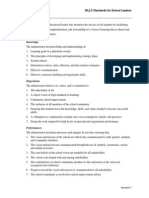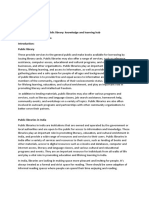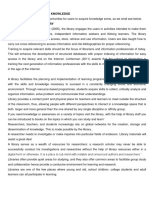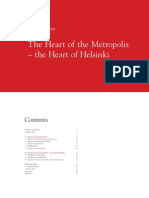Light Perception in Museum and Library
Light Perception in Museum and Library
Uploaded by
MirudhulaCopyright:
Available Formats
Light Perception in Museum and Library
Light Perception in Museum and Library
Uploaded by
MirudhulaCopyright
Available Formats
Share this document
Did you find this document useful?
Is this content inappropriate?
Copyright:
Available Formats
Light Perception in Museum and Library
Light Perception in Museum and Library
Uploaded by
MirudhulaCopyright:
Available Formats
Mirudhula
LIGHT PERCEPTION IN MUSEUM AND LIBRARY
INTRODUCTION:
In the modern information society, libraries and information centres have a new
role to play. This is due to increasing use of web-based information sources and
electronic services. Libraries are also being managed in a more democratic way
due to flexible communication system and efficient work organisation. Their
services are also user-centric. A museum is a not-for-profit, permanent institution in
the service of society that researches, collects, conserves, interprets and exhibits
tangible and intangible heritage .
AIM:
"To understand the role of a public library not only as a storage of books for
individual development but also in terms of community growth." The research aims
to understand the how light and shadow creates space qualitative and quantitative in
aspects of museum and reading space in library.
OBJECTIVES
1. To study the activity chart of a conventional library and design it into a
multifunctional space
2. Provide public access to major collections of the world's literature and knowledge,
including the community's own literature, either through temporary reading or
membership by providing an opportunity for the community to develop the skills and
attitudes which will encourage usage of the space.
3. To achieve individual as well as community learning and also meet the educational
needs of children and young people.
4. To create a research organization by providing public access to the internet as well
as information in traditional formats.
5. Merging the community art and books with qualitative space.
7.Analyzing the consideration in aspect of lighting.
8.Findings and discussion of different strategies of natural lighting and shadow in
design.
NEED of STUDY:
• Collect and provide books as well as other non-book materials to help the people to
become aware of the thinking of others and to think and act independently.
• Foster and promote the spread of knowledge, education and culture;
• Provide facility for formal and informal life-long self-education in the community;
Libraries play an important role in the socio-economic, cultural and educational
development of a society. Let us now study the role of libraries in modern society and
education.
SCOPE AND LIMITATIONS:
1. The library will help students do better in school and will give students books to
practice reading.
2.It will bring new information into the community by the preserve the traditions ,
stories, music and idea of the community .
3. It will give extension workers, health care providers and other professionals
technical
Mirudhula
information to help them do their jobs better.
4. There will be a new way of focussing on usage of a space, day-and-night
5. The library will connect different age groups with allied spaces.
6. To build a collection of functions which will tend to be more reliable and of higher
quality information. A more meaningful use of technology for research purposes.
Psychological, physiological and experiential components are observed in the
museum environment to analyze lighting design within its exhibits.
Design possibilities with light in museum are however not only limited to the display
of art. Research shows how light is able to upgrade exhibition spaces to become
qualitative cultural brands – ranging from the exhibition & sculpture garden to the
shop & café .
LIMITATIONS:
I. There is no well-known accepted criteria/standard for evaluating the public
libraries at
national level.
2. The evaluation of the users on the library resources and services are not always
reliable as these are based on their limited needs and views.
3. A majority of the users are not aware of the various roles of public libraries in the
community and these may indirectly reflect in their perceptions.
This is a primary reason why conventional libraries are losing its importance, due to
introduction of digital formats in these libraries.
You might also like
- A Proposed Hybrid City Library Enhancing Collaborative Learning Through Social ArchitectureDocument8 pagesA Proposed Hybrid City Library Enhancing Collaborative Learning Through Social ArchitectureAliah Gabrielle SantosNo ratings yet
- Unit 1: Teaching Science in Elementary Grades: An OverviewDocument43 pagesUnit 1: Teaching Science in Elementary Grades: An OverviewJenjen Gammad82% (17)
- Use of Library, Study Skills and Ict Lecture Notes GST 121: Course LecturersDocument42 pagesUse of Library, Study Skills and Ict Lecture Notes GST 121: Course LecturersAdebola oluwadamilare prosper100% (11)
- CHAPTER ONE Proposal PDFDocument14 pagesCHAPTER ONE Proposal PDFcarol100% (2)
- Tables of Planetary Phenomena: Click HereDocument5 pagesTables of Planetary Phenomena: Click Herea2983161010% (3)
- ISLLC Standards (Complete)Document9 pagesISLLC Standards (Complete)ashraf-hassanNo ratings yet
- Anatomy of A StreetDocument55 pagesAnatomy of A StreetJairo Marin BarraganNo ratings yet
- Amagsila, J. v2Document9 pagesAmagsila, J. v2Diether Uera MiclaNo ratings yet
- Public Library SynopsisDocument5 pagesPublic Library SynopsisMian Umair Naqsh0% (2)
- A PUBLIC LIBRARY SynopsisDocument10 pagesA PUBLIC LIBRARY SynopsisSuman KumariNo ratings yet
- Final PHD SynopsisDocument6 pagesFinal PHD SynopsissagarkumbharNo ratings yet
- Wa0014.Document8 pagesWa0014.AMIT PATILNo ratings yet
- Public Library Cum Public ParkDocument2 pagesPublic Library Cum Public ParkVAISHALI RAMESHNo ratings yet
- Literature Review - 27-04-2023 Madhu Bhandari PDFDocument22 pagesLiterature Review - 27-04-2023 Madhu Bhandari PDFmadhu bhandariNo ratings yet
- Course Material For Pde 5107 Online ClassDocument113 pagesCourse Material For Pde 5107 Online ClasschrizyboyziNo ratings yet
- Reimaging Public LibrariesDocument6 pagesReimaging Public LibrariesEkta AgarwalNo ratings yet
- Types of LibrariesDocument11 pagesTypes of LibrariesGashbin .muhamadNo ratings yet
- University of Iles3Document4 pagesUniversity of Iles3Adewale Peter OlowatosinNo ratings yet
- Lekshmi RajDocument6 pagesLekshmi RajAjith ManuNo ratings yet
- Library As Gateway of KnowledgeDocument5 pagesLibrary As Gateway of KnowledgeAtuha PeterNo ratings yet
- Cavite Provincial LibraryDocument18 pagesCavite Provincial LibraryJunette Monton SambatNo ratings yet
- Role of Library in Changing Society Dr.K.MuruganDocument7 pagesRole of Library in Changing Society Dr.K.MuruganPritam TonyNo ratings yet
- Types of LibrariesDocument4 pagesTypes of LibrariesLalin-Mema LR100% (1)
- Role of Library in Changing Society KigDocument7 pagesRole of Library in Changing Society KigPritam TonyNo ratings yet
- Pacun Research Design 7Document17 pagesPacun Research Design 7Kevin RamosNo ratings yet
- Lib 001 Course Use of LibraryDocument15 pagesLib 001 Course Use of Libraryifeoluwadaniel824No ratings yet
- Role of Library in Changing Society Dr.K.MuruganDocument7 pagesRole of Library in Changing Society Dr.K.MuruganPritam TonyNo ratings yet
- District LibraryDocument7 pagesDistrict LibraryRawan GhanemNo ratings yet
- Use of A LibraryDocument4 pagesUse of A LibraryAdeel AhmadNo ratings yet
- Arch Desg - LibraryDocument2 pagesArch Desg - LibraryPoornima JayarajNo ratings yet
- Exemplary Paper 1Document9 pagesExemplary Paper 1yili27807No ratings yet
- 5RAri F1Document7 pages5RAri F1Victory OjugbaNo ratings yet
- The Heart of The Metropolis - The Heart of Helsinki: Central LibraryDocument59 pagesThe Heart of The Metropolis - The Heart of Helsinki: Central LibraryLuis GemeloNo ratings yet
- Role of LibrariesDocument19 pagesRole of LibrariesChandrashekhara NNo ratings yet
- Initial Research - Bay, Ygima R.Document11 pagesInitial Research - Bay, Ygima R.YGIMA BAYNo ratings yet
- Bli-221: Library, Information and Society Tutor Marked AssignmentDocument15 pagesBli-221: Library, Information and Society Tutor Marked Assignmentsandeep100% (1)
- Attia IqbalDocument19 pagesAttia Iqbal3444900809No ratings yet
- Survey Questionnaire LiteratureDocument3 pagesSurvey Questionnaire LiteratureJohn Lovewell NarvasaNo ratings yet
- Role of Library in ResearchDocument6 pagesRole of Library in Researchchithrakannan5253100% (1)
- A Critical Analysis of Traditional and Modern LibrariesDocument7 pagesA Critical Analysis of Traditional and Modern Librariesmtuwacynthia86No ratings yet
- Going Beyond the Shelves: Ground-Breaking Library Management StrategiesFrom EverandGoing Beyond the Shelves: Ground-Breaking Library Management StrategiesNo ratings yet
- The Role of Libraries in Cultivating Reading HabitsDocument4 pagesThe Role of Libraries in Cultivating Reading HabitsLibrarianNo ratings yet
- Final Porposal of Public Library 08-02-2023 by Madhu BhandariDocument11 pagesFinal Porposal of Public Library 08-02-2023 by Madhu Bhandarimadhu bhandariNo ratings yet
- Global Issues and Trends in Library Education and Information Sciences in The 21st Century and BeyondDocument13 pagesGlobal Issues and Trends in Library Education and Information Sciences in The 21st Century and BeyondJoshua ihuomaNo ratings yet
- Library PolicyDocument24 pagesLibrary PolicyKichu KNo ratings yet
- Activity 3. Using The Guide Questions, Analyze The Content of The Picture BelowDocument2 pagesActivity 3. Using The Guide Questions, Analyze The Content of The Picture BelowAnthonyNo ratings yet
- Fieldwork Report of C. NdzwanaDocument11 pagesFieldwork Report of C. NdzwanaLutho NdlaziNo ratings yet
- Towards A Better Design Physical Interior Environments of Public Libraries in Peninsular MalaysiaDocument13 pagesTowards A Better Design Physical Interior Environments of Public Libraries in Peninsular MalaysiaSabar PurnomoNo ratings yet
- Infrastructures: Smart LibrariesDocument11 pagesInfrastructures: Smart LibrariesNguyen Phuong Nam (K14 HL)No ratings yet
- Intro & LibraryDocument4 pagesIntro & LibraryNurul NabilahNo ratings yet
- The Effects of Tobacco On Our Mental HealthDocument27 pagesThe Effects of Tobacco On Our Mental HealthPau CruzNo ratings yet
- OAU Lib ThesisDocument78 pagesOAU Lib ThesisOdesola VictorNo ratings yet
- Summary A Proposal 1 - 24 Hour Library StudyDocument3 pagesSummary A Proposal 1 - 24 Hour Library StudyJevee BalagbaganNo ratings yet
- School Library SpecificationsDocument106 pagesSchool Library SpecificationsLab ConMicsNo ratings yet
- Public LibraryDocument14 pagesPublic Libraryaryan12gautam12No ratings yet
- Better Public LibrariesDocument17 pagesBetter Public LibrariesHelenKukiNo ratings yet
- SUM A (Shopping Mall)Document2 pagesSUM A (Shopping Mall)Freddie AgacetaNo ratings yet
- 100 Level Use of Library UpdatedDocument20 pages100 Level Use of Library Updatedwhyte.laura2024No ratings yet
- Library and Its UsersDocument109 pagesLibrary and Its UsersUrdu Academy100% (1)
- 21st Century Libraries Changing Forms, Changing FuturesDocument23 pages21st Century Libraries Changing Forms, Changing Futuresak2004jaf100% (1)
- Library Vocabulary: A Terminology for Librarians and StudentsFrom EverandLibrary Vocabulary: A Terminology for Librarians and StudentsNo ratings yet
- Laying the Foundation: Digital Humanities in Academic LibrariesFrom EverandLaying the Foundation: Digital Humanities in Academic LibrariesRating: 3 out of 5 stars3/5 (1)
- Geoforum: Rutgerd BoelensDocument14 pagesGeoforum: Rutgerd BoelensAnonymous YDyX1TrM2No ratings yet
- Phase Three Assessment and Reflection Knowing That Standards Are Met - Zachary RolandDocument11 pagesPhase Three Assessment and Reflection Knowing That Standards Are Met - Zachary Rolandapi-594749217No ratings yet
- Long Quiz in Inquiry, Investigation and ImmersionDocument2 pagesLong Quiz in Inquiry, Investigation and ImmersionDiana San Diego80% (5)
- ATC DissertationDocument220 pagesATC DissertationRohazlina HassimNo ratings yet
- 0055 PDFDocument2 pages0055 PDFlukasesaneNo ratings yet
- Lesson 2. Doing PhilosophyDocument13 pagesLesson 2. Doing PhilosophyIra Jesus Yapching Jr.No ratings yet
- Basic Interpretive Design-1Document10 pagesBasic Interpretive Design-1Gitaayu ardiawantanaputriNo ratings yet
- 优秀的研究论文论文陈述例子Document11 pages优秀的研究论文论文陈述例子kqtrfphjf100% (1)
- Haptics of The Heart The Sense of Touch in American Religion and CultureDocument25 pagesHaptics of The Heart The Sense of Touch in American Religion and CultureRaúl DíazNo ratings yet
- Cambridge Management - Across.cultures.3rd - Ed C3 Cultural Environments-TrangDocument11 pagesCambridge Management - Across.cultures.3rd - Ed C3 Cultural Environments-TrangNguyễn KhảiNo ratings yet
- Reflections On Philosophy of EducationDocument6 pagesReflections On Philosophy of EducationArlene Amistad AbingNo ratings yet
- Literature Review Independent VariableDocument6 pagesLiterature Review Independent Variableafdtvdcwf100% (1)
- Modern Philosophy: DR Mohammed Muneer'Deen Olodo Al-Shafi'I Page 1-9Document16 pagesModern Philosophy: DR Mohammed Muneer'Deen Olodo Al-Shafi'I Page 1-9najmi smaamNo ratings yet
- 2020 VCE English Written Examination Report: General CommentsDocument11 pages2020 VCE English Written Examination Report: General Commentsivan7tatNo ratings yet
- Estevão de Rezende Martins. CONSCIÊNCIA HISTÓRICA E FORMAÇÃO DE IDENTIDADE DEPENDÊNCIA MÚTUADocument16 pagesEstevão de Rezende Martins. CONSCIÊNCIA HISTÓRICA E FORMAÇÃO DE IDENTIDADE DEPENDÊNCIA MÚTUALia FariaNo ratings yet
- Strategies For Knowledge Management SuccessDocument350 pagesStrategies For Knowledge Management Successwhayperez100% (2)
- The Aristotelian Society, Oxford University Press Proceedings of The Aristotelian Society, Supplementary VolumesDocument40 pagesThe Aristotelian Society, Oxford University Press Proceedings of The Aristotelian Society, Supplementary VolumesSweet SoulNo ratings yet
- What Is Knowledge in BusinessDocument2 pagesWhat Is Knowledge in BusinessFarzana AksarNo ratings yet
- Example Rationale For Literature ReviewDocument8 pagesExample Rationale For Literature Reviewafmzvjvjzoeqtg100% (1)
- Classroom Challenges Encountered by Pre-Service Science Teachers From Abuyog Community CollegeDocument37 pagesClassroom Challenges Encountered by Pre-Service Science Teachers From Abuyog Community CollegeJhon Rex A. RomblonNo ratings yet
- Being en RouteDocument13 pagesBeing en RouteJuan Antonio Del MonteNo ratings yet
- Adventist University of The Philippines: College of Arts and Humanities Course Syllabus IN Understanding THE SelfDocument14 pagesAdventist University of The Philippines: College of Arts and Humanities Course Syllabus IN Understanding THE SelfSheryll Ann CastilloNo ratings yet
- How To Write A Case Study Literature ReviewDocument8 pagesHow To Write A Case Study Literature Revieweeyjzkwgf100% (1)
- Discussion PaperDocument26 pagesDiscussion PaperAngélica VedanaNo ratings yet
- Guidelines InternshipDocument2 pagesGuidelines Internshiprichu4rixonNo ratings yet
























































































